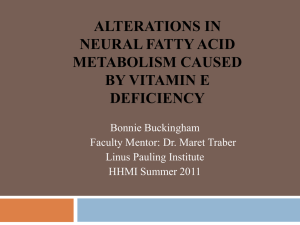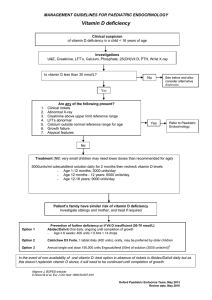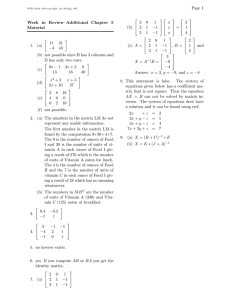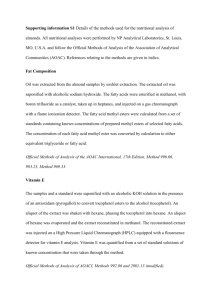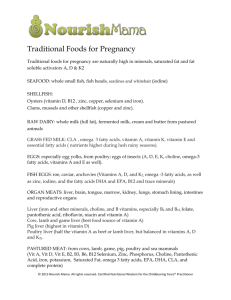ALTERATIONS IN NEURAL FATTY ACID METABOLISM CAUSED BY VITAMIN E
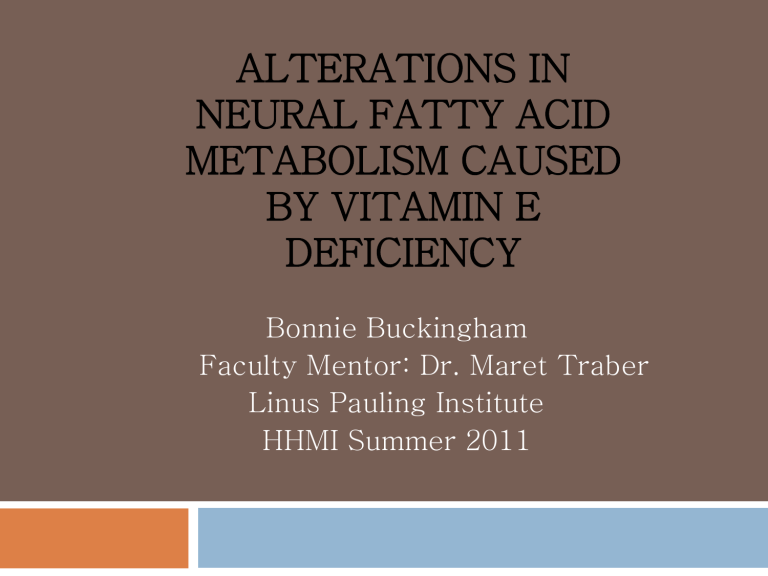
ALTERATIONS IN
NEURAL FATTY ACID
METABOLISM CAUSED
BY VITAMIN E
DEFICIENCY
Bonnie Buckingham
Faculty Mentor: Dr. Maret Traber
Linus Pauling Institute
HHMI Summer 2011
Outline
•
•
•
•
•
•
•
•
•
Significance
Background
Hypothesis
Genes of interest
Model organism
Methods
Results
Conclusion
Questions
Significance
Oxidative damage in the brain is believed to play a role in degenerative diseases such as
Alzheimer's and dementia
Patients with Alzheimer's have low levels of vitamin E in their cerebrospinal fluid (Kontush et al., Acad Science 2004)
Alpha tocopherol supplementation of 2000 IU has been shown to slow the progression of
Alzheimer's and dementia, but the mechanism is unknown. (Sano M, Ernesto C, Thomas RG, et al,
N Engle J Med. 1997.)
Vitamin E
(Alpha tocopherol)
Exists in 8 isomers:
Alpha, beta, gamma, and delta tocopherol
Alpha, beta, gamma, and delta tocotrienol
Alpha tocopherol is preferentially retained due to the action of the tocopherol transfer protein in the liver (DRI, 2000)
Vitamin E
(Alpha tocopherol)
Lipid soluble vitamin
Principal role is to protect polyunsaturated fatty acids from peroxidation
Deficiency can cause peripheral neuropathy
Vitamin E
(Alpha tocopherol)
Donates a hydrogen from the free hydroxl group on the aromatic ring
R · RH
DHA (Docosahexaeonic acid)
(22:6 ω3 )
Important long chain fatty acid created by elongating omega 3 fatty acids or consumed as fish oil
Comprises ~50% of brain fatty acids
(Bazar, et al. AnnuRev Nutr 2011)
Wide variety of cellular functions:
Gene regulation, membrane fluidity, precursor for some signaling molecules
DHA
DHA is very susceptible to peroxidation due to the high amount of unsaturation in the aliphatic tail
•
•OH
Hypothesis
We hypothesize that vitamin E protects DHA from lipid peroxidation
Prediction
Zebrafish fed a vitamin E deficient diet:
1)
Will have increased levels of lipid peroxidation
2)
3)
Will have an increase in mRNA expression of enzymes responsible for polyunsaturated fatty acid synthesis to replace any DHA lost to lipid peroxidation
However, due to the deficiency of vitamin E in the diet, the increase in mRNA expression will be insufficient to replace DHA lost in the brain.
Model Organism
Zebrafish
Currently established model in the
Traber/Tanguay laboratories
Similar fatty acid metabolism pathways as humans (Lebold et al J Nutr, accepted)
Easily manipulated diet with defined ingredients
Method
Overview
Defined diet without Vit E
(E-, n=30)
Brains
60
Total
Fish
Defined diet with Vit E
(E+, n=30)
Livers Eyes
Protein expression changes mRNA expression changes
Fatty Acid concentrations
Proteins involved in fatty acid synthesis
2.
3.
4.
1.
Sterol regulatory binding factor 1
(SREBP1)
Fatty acid desaturase (fads2)
Elongase (elovl2)
Elongase (elovl4)
Sterol regulatory binding factor
1 ( SREBP1 )
Regulates genes related to lipid metabolism and fatty acid synthesis
Fatty acid desaturase (
fads2
)
Removes two hydrogens from a fatty acid in order to create a double bond
Required for the synthesis of DHA from
Omega-3 fatty acids
mRNA measured in the liver and brain
Elongase ( elovl2 )
Catalyzes the synthesis of polyunsaturated very long chain fatty acids
Elongates fatty acids by adding 2 carbons
mRNA measured in the liver and brain
Elongase (
elovl4
)
Catalyzes the synthesis of polyunsaturated very long chain fatty acids
Elongates fatty acids by adding 2 carbons
Specifically expressed in neural tissues
mRNA measured in the eye and brain
DHA
Tripathy S, Torres-Gonzalez M, Jump DB. J Lipid Res. 2010 Sep;51(9):2642-54
Methods
Adult zebrafish fed a vitamin E sufficient or deficient diet were euthanized and brains, livers, and eyes removed for analysis
Methods
Fatty acid concentrations were determined using high pressure liquid chromatography coupled to a single-quad mass spectrometer
Vitamin E concentrations were determined using high pressure liquid chromatography with electrochemical detection
Methods
mRNA expression, evaluated using quantitative real time PCR, were:
fatty acid desaturase (fasd2)
elongase (elovl2, elovl4)
Protein expression of SREBP1 was determined using western blotting
Results
Diet impact on vitamin E levels
Diet
P<0.0001
Tissue
P=0.2772
Diet x Tissue
P=0.0001
Columns not sharing the same letter are significantly different
Vitamin E deficiency did not affect fatty acid concentrations in the liver
Linoleic Acid Arachidonic
Acid
Vitamin E deficiency did not affect fatty acid concentrations in the liver
Alpha
Linolenic Acid DHA EPA
Vitamin E deficiency did not affect
Elovl2 or FADs2 mRNA expression in the liver
Elovl2 Fads2
Fatty Acid Concentration in the
Brain
No data available due to equipment failure.
Vitamin E deficiency did not affect mRNA expression in the brain
Elovl4 Elovl
2
Fads
2
Vitamin E deficiency increases eye
EPA and linoleic acid concentrations
Linoleic Acid EPA
Vitamin E deficiency tended to decrease DHA concentration in the
Alpha eye
Arachidonic DHA
Linolenic Acid Acid
Correlation between eye
DHA and α -tocopherol
R value
0.5081
P value
0.02
Vitamin E deficiency did not affect eye Elovl4 mRNA expression
Elovl4
Summary
With regard to neural tissues, vitamin E deficiency in eyes (brain unstudied):
tended to decrease DHA levels
vitamin E and DHA concentrations were positively correlated
Other PUFA concentrations increased
With regard to the liver, vitamin E deficiency:
did not change liver fatty acid concentrations
Summary, continued
Vitamin E deficiency did not alter mRNA expression of FADs2, Elovl2, and Elovl4 in any tissues studied (brain, eye, liver)
Conclusion
Vitamin E in the eye was not depleted sufficiently to allow DHA oxidation
With lower vitamin E concentrations less
DHA was observed
Vitamin E deficiency did not alter mRNA expression of FADs2, Elovl2, and Elovl4 in any tissues studied (brain, eye, liver)
Vitamin E deficiency did not change liver fatty acid concentrations
More samples are being analyzed
Limitations
SREBP expression: Data not available due to western blotting optimization problems
Data not available for DHA in the brain due to equipment failure
Acknowledgements
Linus Pauling Institute
Dr. Maret Traber
Dr. Kevin Ahern
Katie Lebold
Carrie Barton
The Traber Lab/ONSL/SARL
HHMI, EHSC
